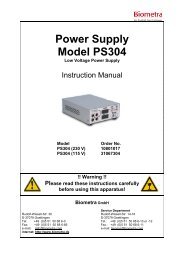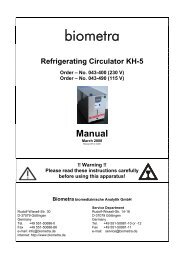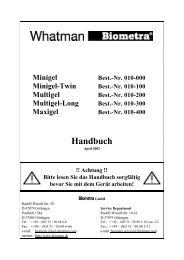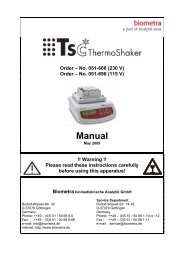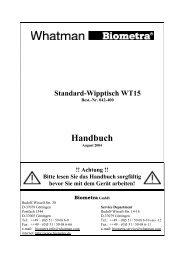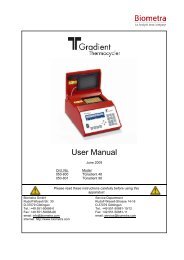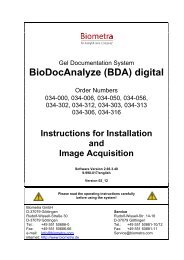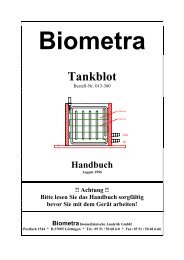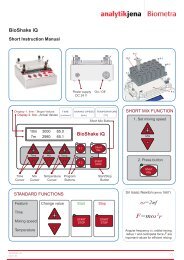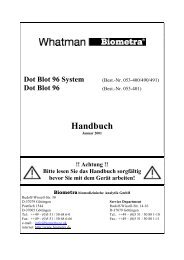Model PS9009 TC Programmable Electrophoresis Power Supply
Model PS9009 TC Programmable Electrophoresis Power Supply
Model PS9009 TC Programmable Electrophoresis Power Supply
Create successful ePaper yourself
Turn your PDF publications into a flip-book with our unique Google optimized e-Paper software.
Operating<br />
Instructions<br />
Note: The temperature control option<br />
can be used with any of the programs<br />
stored in the memory of the <strong>Model</strong><br />
<strong>PS9009</strong> <strong>TC</strong> <strong>Power</strong> <strong>Supply</strong>.<br />
Once the temperature drops below the set point, both voltage and current output is<br />
resumed at the preset levels. The use of the temperature regulation mode prevents<br />
the activation of the power (Watt) regulation mode.<br />
1. Switch the AC Mains <strong>Power</strong> ON/OFF switch to the ON position. An alarm<br />
sounds to signify the start up of power.<br />
2. Press the Start/Stop keypad to silence the alarm. The last program used is<br />
displayed.<br />
3. Press the Program keypad and enter the program number using the numerical<br />
keypad.<br />
4. Program the desired parameters for electrophoresis. Instead of programming<br />
Watts, press the W/°C keypad a second time. The display shows _ _ _ °C<br />
instead of _ _ _ W. Enter the desired upper temperature limit for the gel. The<br />
range goes from 00° to 99° C. For example 40°C would be entered as 040.<br />
0000 V 000 mA 040°C P01<br />
00000 MinR 0000 MinT S#<br />
The display MinR is a timer that is dedicated for increments of minutes while the<br />
<strong>Model</strong> <strong>PS9009</strong> <strong>TC</strong> does not supply current or voltage. This timer works only when<br />
the voltage and current are turned off in the temperature regulation mode. The main<br />
timer (MinT) remains operational at all times during the operation of the power<br />
supply and provides the automatic termination of the voltage and current output.<br />
After the electrophoresis has automatically stopped, it may be necessary to<br />
continue electrophoresis for the time that the voltage was discontinued.<br />
3.5 Setting Safe Operating Limits<br />
Electrophoretic chambers are generally designed for a relatively specific purpose.<br />
For example, submarine chambers use agarose gels to separate DNA or RNA<br />
fragments, while a DNA sequencing chamber is almost always used to separate<br />
DNA in a denaturing polyacrylamide gel. In each case, the voltage, milliamp, and<br />
wattage requirements are well defined within a reasonable range of values. In cases<br />
such as these, the user can safely assume that the manufacturer has designed the<br />
chamber to withstand the voltage and heat energy necessary to perform the<br />
electrophoretic separation when standard protocols are followed.<br />
Some types of electrophoretic chambers are specifically designed to be<br />
multipurpose devices. For example, a vertical slab gel chamber could be used for<br />
anything from DNA sequencing to isoelectric focusing, depending on the gel type<br />
and buffer system used. Choosing safe operating limits for a chamber of this type<br />
requires a higher degree of caution. Chamber manufacturers normally rate their<br />
product for maximum voltage and/or maximum wattage. Whenever possible, contact<br />
the manufacturer and request this information.<br />
Whether you use special purpose or multipurpose chambers, the maximum<br />
operating temperature the chambers will withstand is a critical aspect of safe<br />
operation. Most electrophoretic chambers (with a few notable exceptions) are made<br />
of acrylic and plastic and should operate below a temperature of 35°C. If there is a<br />
lack of information about the capabilities of the chamber being used, regular<br />
monitoring of the operating temperature is recommended. This should be<br />
accomplished without coming into physical contact with the chamber when voltage<br />
is applied.<br />
The following procedure illustrates how normal operating conditions can be<br />
determined and how this information can be used to choose safe operating limits for<br />
agarose gel electrophoresis in a submarine chamber at a constant voltage of<br />
125 V.<br />
6





